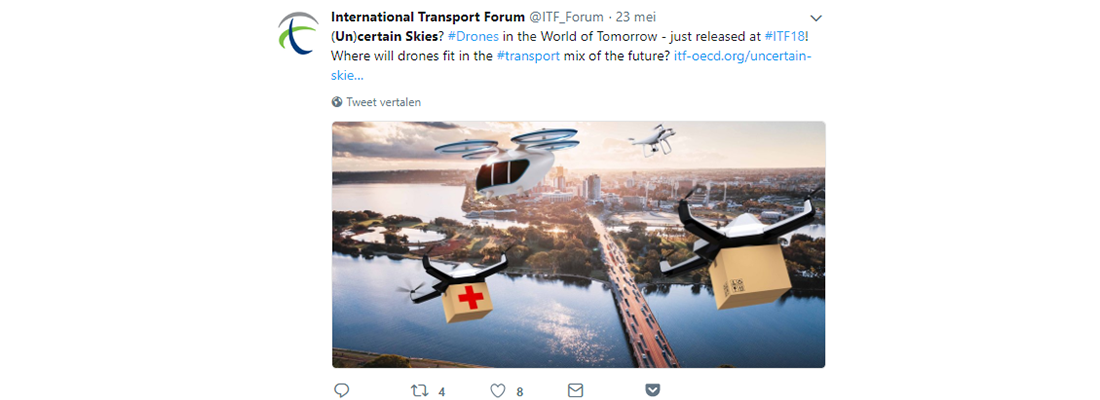On 23 may this year a report entitled '(Un)Certain Skies? Drones in the World of Tomorrow' was published by the International Transport Forum, that researches the role of drones as part of the future transport mix.
Drones in the World of Tomorrow
This report looks into the role of drones in future urban mobility. An important aspect of the report is dedicated to the problems policy makers face in engaging with the fast growing commercial drone sector. The potential impact that commercial RPAS will have on our world is one that we cannot yet fully comprehend. We’re quite good in predicting the potential impact of (current) drone applications in a specific sector, but across industries the possibilities seem endless. Unmanned cargo and freight vehicles for urban and far distance deliveries and eventually on-demand air transport are solutions that potentially have both positive impacts (such as improved connectivity, fast travelling, etc) and negative impacts (privacy, noise disturbance, increasing use of energy, and more).
Anticipating impact
The report explores how these impacts can be anticipated and included in (safety) guidelines to support policy makers in the introduction of new legislations. The insights in this report are built on expert views (conducted interviews), published research and a workshop with 37 international experts held at the Uber headquarters in San Francisco in the end of last year. This workshop brought together drone manufacturers, regulatory bodies, humanitarian and economic organisations and representatives of companies that use drones as a central component of their businesses, or are planning to do so in the near future.
Drones, the technologies that enable them and their potential applications within the transport sector are already diverse and are evolving rapidly. Future use cases range from on-demand passenger drone services and fleets of freight delivery drones in urban areas to fully automated drones carrying large payloads and connecting continents in an airborne “conveyor belt”. Drones also offer many promising support functions for transport systems. For instance, sensor-equipped drones can help to plan, maintain and manage transport infrastructure and traffic flows more effectively.

Preparing for tomorrow
A sneak preview from this chapter: Collecting and sharing data on drones to understand their impact and tailor policies. Read the full report here.
"The availability of accurate, timely and meaningful data is key for governments, industry and civic society to understand the proper functioning of any kind of system. Aviation has a long tradition of collecting and sharing extensive operational and performance data sets, which are then used to formulate policies and regulations, monitor the industry and predict future needs. The importance of statistics in aviation is captured in Article 67 of the Chicago Convention (ICAO, 1944) which requires states to collect data on traffic, costs and financial statements for international aviation. Most countries also do the same for domestic aviation. However, with respect to unmanned aircraft, data is sorely lacking. Basic information such as the number of aircraft is practically non-existent, except in jurisdictions where registration is mandatory. Aside from possibly knowing the number and composition of the (leisure) drone fleet, very little data is currently available. As a starting point, data on individual aircraft characteristics, the number of flights during a given period, the number of flight hours during that period, the types of mission flown and eventually the number of passengers and the weight of freight carried should be collected in order to enable authorities to conduct meaningful safety, security and economic analysis.”






